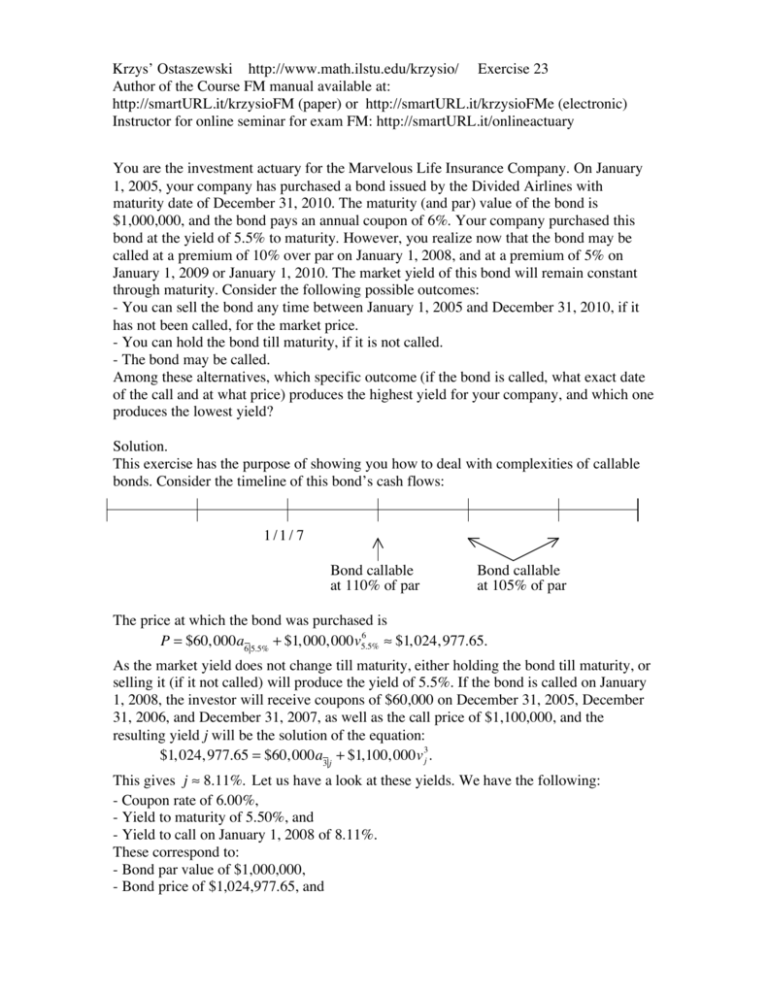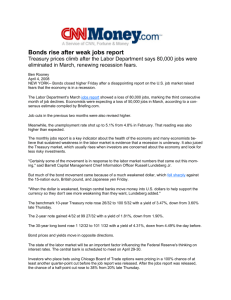
Krzys’ Ostaszewski http://www.math.ilstu.edu/krzysio/ Exercise 23
Author of the Course FM manual available at:
http://smartURL.it/krzysioFM (paper) or http://smartURL.it/krzysioFMe (electronic)
Instructor for online seminar for exam FM: http://smartURL.it/onlineactuary
You are the investment actuary for the Marvelous Life Insurance Company. On January
1, 2005, your company has purchased a bond issued by the Divided Airlines with
maturity date of December 31, 2010. The maturity (and par) value of the bond is
$1,000,000, and the bond pays an annual coupon of 6%. Your company purchased this
bond at the yield of 5.5% to maturity. However, you realize now that the bond may be
called at a premium of 10% over par on January 1, 2008, and at a premium of 5% on
January 1, 2009 or January 1, 2010. The market yield of this bond will remain constant
through maturity. Consider the following possible outcomes:
- You can sell the bond any time between January 1, 2005 and December 31, 2010, if it
has not been called, for the market price.
- You can hold the bond till maturity, if it is not called.
- The bond may be called.
Among these alternatives, which specific outcome (if the bond is called, what exact date
of the call and at what price) produces the highest yield for your company, and which one
produces the lowest yield?
Solution.
This exercise has the purpose of showing you how to deal with complexities of callable
bonds. Consider the timeline of this bond’s cash flows:
1/1/ 7
1/1/ 5
Bond callable
at 110% of par
Bond callable
at 105% of par
The price at which the bond was purchased is
6
P = $60, 000a6 5.5% + $1, 000, 000v5.5%
! $1, 024, 977.65.
As the market yield does not change till maturity, either holding the bond till maturity, or
selling it (if it not called) will produce the yield of 5.5%. If the bond is called on January
1, 2008, the investor will receive coupons of $60,000 on December 31, 2005, December
31, 2006, and December 31, 2007, as well as the call price of $1,100,000, and the
resulting yield j will be the solution of the equation:
$1, 024, 977.65 = $60, 000a3 j + $1,100, 000v 3j .
This gives j ! 8.11%. Let us have a look at these yields. We have the following:
- Coupon rate of 6.00%,
- Yield to maturity of 5.50%, and
- Yield to call on January 1, 2008 of 8.11%.
These correspond to:
- Bond par value of $1,000,000,
- Bond price of $1,024,977.65, and
- Call exercise price of $1,100,000.
If the market yield were at 6%, this bond would trade at par. But the market yield is
5.5%, so that the bond’s higher (than 5.5%) coupon of 6% causes it to trade at premium
of $24,977.65. It would seem therefore that the issuer would find it advantageous to call
the bond as early as possible. That would be the case if the call exercise price were par.
But instead the call exercise price is $1,100,000, i.e., a 10% premium of $100,000 over
par. Note also that between January 1, 2005 and January 1, 2008, this bond’s premium
would be gradually amortized, and in fact the price as of January 1, 2008 at the yield of
5.5% would be (note that three coupons paid on December 31, 2008, December 31, 2009,
and December 31, 2010, remain):
3
P = $60, 000a3 5.5% + $1, 000, 000v5.5%
! $1, 013, 489.67.
Calling this bond selling for $1,013,489.67 at the call exercise price of $1,100,000 would
be clearly disadvantageous to the issuer and very advantageous to the investor, resulting
in the high total rate of return of 8.11%.
As of January 1, 2009, this bond can be called at the call exercise price of
$1,050,000. If it called immediately that day, the return to the investor is the solution of
the equation:
$1, 024, 977.65 = $60, 000a4 j + $1, 050, 000v 4j .
This results in j ! 6.41%. Note that we know that this yield has to be lower than the
previous one (for call on January 1, 2008), as the investor gains $60,000 in one extra
coupon, but loses $50,000 in the call exercise price, and the net $10,000 is less than
income that the previous call exercise value of $1,100,000 would earn in 2008, under any
of the interest rates considered. Let us also observe that the price based on the yield to
maturity of 5.5% as of January 1, 2009 is
2
P = $60, 000a2 5.5% + $1, 000, 000v5.5%
! $1, 009, 231.60.
The premium is further reduced and the call is disadvantageous to the issuer, as the issuer
would have to pay $1,050,000 for a bond with cash flows to maturity worth
$1,009,231.60. Note however, that while the bond premium has declined, the call
premium has declined more, and the relative disadvantage to the issuer is less. The
relative advantage to the investor is also less, as the yield to call has declined from 8.11%
to 6.41%.
If the bond is called on January 1, 2010, the latest possible call date,
$1, 024, 977.65 = $60, 000a5 j + $1, 050, 000v 5j .
This gives j ! 6.28%. We do know again that the later call will result in lower yield to
the investor, as the bond’s yield to maturity is unchanged, but the $1,050,000 cash flow
arrives later. Note also that the price based on the yield to maturity of 5.5% as of January
1, 2010 is
$1, 060, 000
P = $60, 000a1 5.5% + $1, 000, 000v15.5% =
! $1, 004, 739.34.
1.055
This clearly shows that calling this bond for $1,050,000 is even more disadvantageous to
the issuer.
We conclude that the earliest possible call, on January 1, 2008, is the most
advantageous to the investor and the least advantageous to the issuer, resulting in the
yield of 8.11% to the investor. On the other hand, waiting till maturity of December 31,
2010 is the most advantageous course of action for the issuer, and the least advantageous
to the investor, resulting in the yield of 5.5% to the investor.
© Copyright 2005 by Krzysztof Ostaszewski.
All rights reserved. Reproduction in whole or in part without express written
permission from the author is strictly prohibited.








